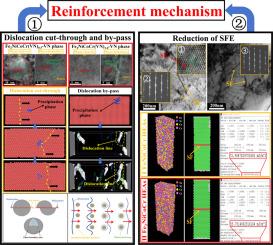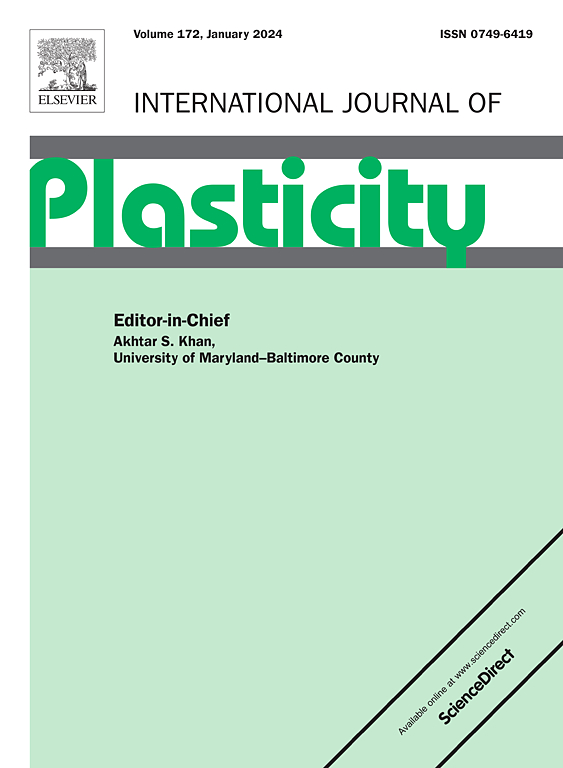Improvement of work-hardening capability and strength of FeNiCoCr-based high-entropy alloys by modulation of stacking fault energy and precipitation phase
IF 9.4
1区 材料科学
Q1 ENGINEERING, MECHANICAL
引用次数: 0
Abstract
Face-centered cubic (FCC) structured FeNiCoCr high-entropy alloys (HEAs) generally demonstrate good plasticity but exhibit relatively low strength. To tackle this challenge, we suggest the following approaches: (1) enhancing work-hardening ability through reducing the stacking fault energy of the alloy system. (2) adjusting the composition of alloying elements to control the formation of precipitation phase, thus fortifying the matrix. Based on the aforementioned perspectives, a series of alloys Fe2NiCoCr(VN)x (x = 0, 0.3, 0.5, 1.0) was designed by adjusting the Fe element content in FeNiCoCr HEAs, and then adding V and N alloying elements to the alloy. Experimental results show that Fe2NiCoCr(VN)0.5 HEAs exhibit high-quality work-hardening ability and strength. The yield strength enhanced from 150 MPa to 250 MPa, while the ultimate tensile strength was enhanced from 540 MPa to 800 MPa. This represents an increase of 66 % in yield strength and 48 % in ultimate tensile strength, respectively. And plasticity remained stable at 25 %, outperforming most as-cast FCC-structured HEAs. The changes in stacking fault energy and the dislocation slip behaviors around the precipitation phase were also calculated by the Molecular Dynamics simulation software Large-scale Atomic/Molecular Massively Parallel Simulator. This study not only reduces costs but also provides insights into the tunability of the mechanical properties of materials through alloying non-equiatomic HEAs.


通过调节层错能和析出相提高fenicocr基高熵合金的加工硬化能力和强度
面心立方(FCC)结构FeNiCoCr高熵合金(HEAs)具有良好的塑性,但强度较低。为了应对这一挑战,我们提出了以下方法:(1)通过降低合金体系的层错能来提高加工硬化能力。(2)调整合金元素的组成,控制析出相的形成,从而强化基体。基于上述观点,通过调整FeNiCoCr HEAs中Fe元素的含量,再添加V、N合金元素,设计出一系列Fe2NiCoCr(VN)x (x=0、0.3、0.5、1.0)合金。实验结果表明,Fe2NiCoCr(VN)0.5 HEAs具有良好的加工硬化能力和强度。屈服强度由150 MPa提高到250 MPa,极限抗拉强度由540 MPa提高到800 MPa。这意味着屈服强度和极限抗拉强度分别提高66%和48%。塑性稳定在25%,优于大多数铸态fcc结构HEAs。利用分子动力学模拟软件Large-scale Atomic/Molecular Massively Parallel Simulator计算了沉淀相周围层错能的变化和位错滑移行为。这项研究不仅降低了成本,而且通过合金化非等原子HEAs,为材料的机械性能的可调性提供了见解。
本文章由计算机程序翻译,如有差异,请以英文原文为准。
求助全文
约1分钟内获得全文
求助全文
来源期刊

International Journal of Plasticity
工程技术-材料科学:综合
CiteScore
15.30
自引率
26.50%
发文量
256
审稿时长
46 days
期刊介绍:
International Journal of Plasticity aims to present original research encompassing all facets of plastic deformation, damage, and fracture behavior in both isotropic and anisotropic solids. This includes exploring the thermodynamics of plasticity and fracture, continuum theory, and macroscopic as well as microscopic phenomena.
Topics of interest span the plastic behavior of single crystals and polycrystalline metals, ceramics, rocks, soils, composites, nanocrystalline and microelectronics materials, shape memory alloys, ferroelectric ceramics, thin films, and polymers. Additionally, the journal covers plasticity aspects of failure and fracture mechanics. Contributions involving significant experimental, numerical, or theoretical advancements that enhance the understanding of the plastic behavior of solids are particularly valued. Papers addressing the modeling of finite nonlinear elastic deformation, bearing similarities to the modeling of plastic deformation, are also welcomed.
 求助内容:
求助内容: 应助结果提醒方式:
应助结果提醒方式:


